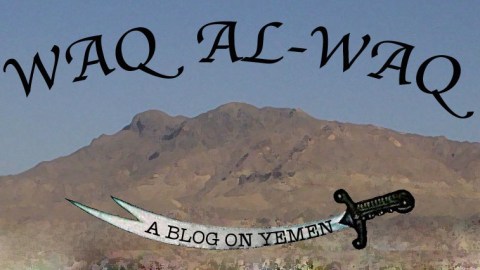Guest Post: “After the Drone”

Editor’s Note: Today I’m thrilled to have a guest post by Adam Baron, an excellent journalist, who is working and writing from Yemen. Today, he wrote a must-read story on his trip to see the aftermath of the November 7 drone strike that killed ‘Adnan al-Qadhi. You can and should read that story here. For more of Adam’s writings, which I highly recommend, visit his website here.
What follows is Adam’s first person account of his trip:
I’d always imagined that I would make it to Beit al-Ahmar at some point. The village, a short drive outside of Sanaa, was the birthplace of former president Ali Abdullah Saleh and number of the key players in his rise and fall to power. Regardless of whether I’d end up gaining any profound insights from any prospective visit, a trip to Saleh’s hometown seemed like a necessity, if only to say I’d been there.
Even if I still find it hard to believe it took place, it was a November 7th drone strike on the outskirts of the village targeting an alleged Al Qaeda militant from a prominent local family that finally brought me to Beit al-Ahmar. Through a series of events I can’t really get in to, I managed to secure passage to now-even-more-notorious town, escorted by the late target’s brother and his driver, who conveniently offered to pick me up a few minutes walk from my house.
It’s hard to describe how it feels, as an American journalist, to drive through Sanaa in the back of an SUV coated in posters commemorating the ‘martyrdom’ by drone of an alleged Al Qaeda militant as his brother sits in the front seat. All the obvious triggers of ill ease almost contradicted each other, mostly leaving me with a low level of paranoia that was largely focused on all the possible ways I could screw things up, ranging from incorrectly conjugating Arabic verbs to failing to suppress nervous laughter. The ride was far from painful; that being said, I’m glad it was short.
The sprawl of Sanaa quickly gives way to rural villages of Sanhan. They’re generally picturesque, but any specifics—save an open Houthi presence that I had already known about but still found surprising—faded from my memory as we approached Beit al-Ahmar. My expectations for Saleh’s hometown refuge were high but I was still blown away by the massive fortress that sprawled across a hill at the entrance to Beit al-Ahmar; in full disclosure, for a good fifteen minutes, I completely lost sight of why I had come out there in the first place. Even for a monumental show of power and extravagance, it seemed excessive, and the palatial homes of other powerful figures seemed almost unimpressive.
The sight of Adnan al-Qadhi’s home, festooned with a large painting of the infamous black flag, brought me back down to earth. It was a rather jarring sight, but it was far from the only weird thing in Beit al-Ahmar, where the homes of Saleh and his erstwhile ally, Ali Mohsen—whose loyalists clashed last fall, transforming parts of Sanaa into a warzone—sat (wholly intact) in virtual spitting distance of each other.
“They leave their issues when they come here,” Himyar, Adnan’s brother deadpanned.
By the time we drove up to the place where Qadhi was killed, I had managed to regain my focus. The site of drone strike was rather unimpressive—struggling to find something for me to photograph besides what was now a bump in a dirt road, some locals pointed out some qat plants that were charred when the missile struck. All things considered, it was a thoughtful, though ultimately ineffective effort. Driving back into town so I could conduct some more interviews, we passed an elementary school that had just dismissed students for the day, which certainly underlined the devastating results of potential errors.
As Himyar plied me with juice and Yemeni knockoffs of Nabisco products, farmers and day laborers made remarks that had an interesting degree of overlap with what educated Sanaanis tend to say about drone strikes, referencing notions of respect for human rights and the rule of law.
Heading to the cemetery where Adnan was buried, I noted that there was only one new grave next to his. In contrast to almost every other local or international media report, Himyar asserted, two, rather than three people were killed in the strike; the discrepancy some 10 miles from Sanaa certainly called the accuracy of death counts of drone strikes in less accessible areas into question. As Adnan’s brother and his driver prayed by his tombstone, it was hard not to feel immensely out of place. The looming presence of Saleh’s monstrous compound proved oddly reassuring, reminding me not to worry as very little, in the end, made much sense here.
When we finally made it back to Sanaa, Himyar made sure his driver got me back to my house safely—forcing me to do some quick-thinking to avoid having my neighbors see my getting out of an SUV festooned with images of an alleged Al Qaeda operative lest they see and get freaked out. Himyar may have made little secret of his desire for revenge and his general fury at the American government, but I can’t say I ever felt remotely like I was in any danger during the morning we spent together.
Ultimately, the whole experience was a weird reminder of one of the biggest challenges of reporting from Yemen: the vast majority of Yemenis—from western-educated politicians to brothers of alleged terrorists—are unusually nice people. It may make a lot of things about my work easier, but it only makes it all the more draining to digest the many-edged series of unfortunate events that seem to characterize this corner of the Arabian Peninsula these days.





